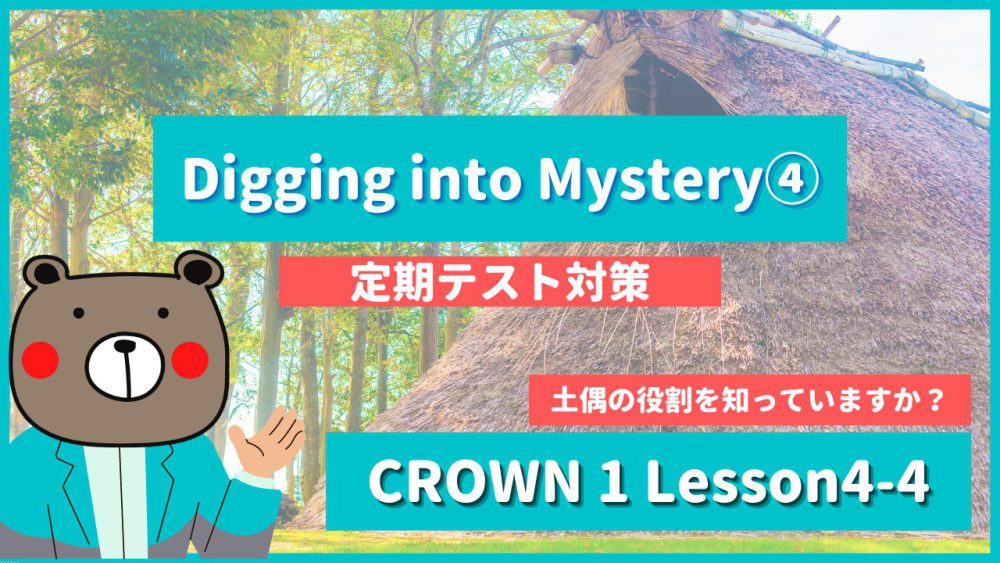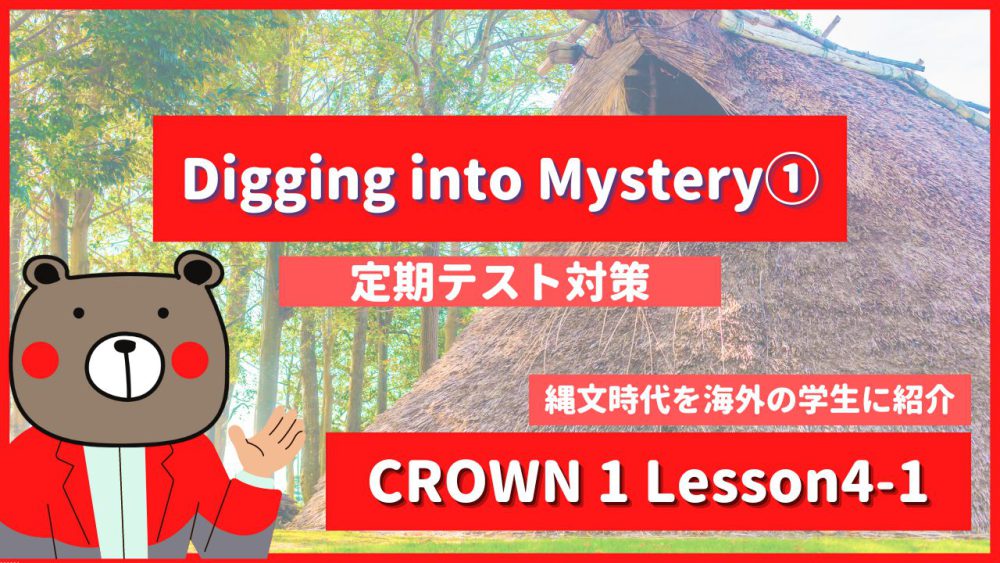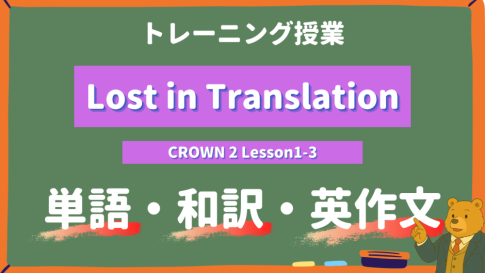▼音声で学びたい方はこちらへ🐻
現在撮影中❗️

▼CROWN1-高1《Lesson4》はこちらから🐻
- 授業前にひとこと
- 勉強のポイント
- 本文&和訳
- 重要単語
- 重要ポイント
- 【1】Life in the Jomon period
- 【2】Thank you, Shota.
- 【3】Since the Jomon people left no written records, researchers have been trying to make a guess about them based on excavations throughout Japan.
- 【4】One of the most important excavations began in 1992 at the Sannai-Maruyama site in Aomori.
- 【5】Researchers found six huge holes in the ground with the remains of wooden pillars (cf. photo 4).
- 【6】They were the base for some large structure (cf. photo 5).
- 【7】The researchers also found evidence of another huge wooden structure.
- 【8】Probably hundreds of families lived in this village.
- 【9】We know that people first arrived there 5,900 years ago.
- 【10】Before that, they had been moving from one place to another, but then some of them chose to live there permanently.
- 【11】They hunted animals, fished in rivers or in the sea, and picked berries and mushrooms.
- 【12】They lived in pit houses and knew how to cook in earthen pots.
- 【13】The Jomon people loved to decorate themselves with jewelry made of bone, stone, and shell.
- 【14】This village had lasted for 1,000 years before it disappeared, perhaps due to climate change.
- 【15】Now, lots of people are coming back to this site, not to live there, of course, but as tourists.
- 【16】Now, Takuya will tell us more about dogu.
授業前にひとこと


今回も、CROWN1-高1《Lesson4》について扱っていきます❗️
Lesson4のタイトルは…🐻
Digging into Mystery
という「海外の高校生に縄文文化についてプレゼンをする」お話です。
ちなみに、このLessonでメインで確認したい文法事項は…
過去完了・過去完了進行形
です❗️
さて、いつも授業前に説明することですが…
⇧に載せてあります『単語・和訳・英作文トレーニング』をテスト1週間前から毎日やってみてください❗️曖昧な理解がなくなり、成績が爆伸びします!!
コミュ英以外の定期テスト対策は?
現代文の定期テスト対策は こちら から
古文の定期テスト対策は こちら から
漢文の定期テスト対策は こちら から
teite channel をもっと活用する


▷ 解説記事のリクエスト
▷ 新着情報のキャッチ
▷ 定期テスト予想問題
▷ オリジナルグッズの販売
ができるようになっています🐻
teite channel の 公式LINEアカウント はこちら
勉強のポイント
①本文は、縄文時代の生活についてミサキがプレゼンをする場面であることを理解する。
②単語・重要ポイントをインプットする。
③過去完了・過去完了進行形について理解する。
本文&和訳
テーマ
【2】Life in the Jomon period
縄文時代の生活
本文
Thank you, Shota.
ありがとう、ショータ。
Since the Jomon people left no written records, researchers have been trying to make a guess about them based on excavations throughout Japan.
縄文人は文書記録(書かれた記録)を残していないので、研究者は日本中の遺跡をもとに、彼らについて推測するのを試み続けてきました。
One of the most important excavations began in 1992 at the Sannai-Maruyama site in Aomori.
最も重要な発掘作業の一つは青森県の三内丸山遺跡で始まりました。
Researchers found six huge holes in the ground with the remains of wooden pillars (cf. photo 4).
研究者は、木製の支柱の遺物とともに、地面に6つの巨大な穴を発見しました(参照:画像4)。
They were the base for some large structure (cf. photo 5).
それらはある程度大きな建物の土台でした(参照:画像5)。
The researchers also found evidence of another huge wooden structure.
研究者はまた、もう一つの巨大な木製の建物の証拠を発見しました。
Probably hundreds of families lived in this village.
おそらく何百もの家族がこの村に住んでいました。
We know that people first arrived there 5,900 years ago.
私たちは、人々が5900年前に初めてそこへ辿り着いたことを知っています。
Before that, they had been moving from one place to another, but then some of them chose to live there permanently.
その前は、彼らはある場所から他の場所へ移住していましたが、彼らの一部は永続的にそこで住むことを選びました。
They hunted animals, fished in rivers or in the sea, and picked berries and mushrooms.
彼らは動物を狩猟したり、川や海で魚を釣ったり、ベリーやキノコを採集しました。
They lived in pit houses and knew how to cook in earthen pots.
彼らは竪穴式住居に住み、土鍋の料理の仕方を知っていました。
The Jomon people loved to decorate themselves with jewelry made of bone, stone, and shell.
縄文人は骨や石や貝殻でできたアクセサリーで自分自身を着飾るのが大好きでした。
This village had lasted for 1,000 years before it disappeared, perhaps due to climate change.
この村は、おそらく気候変動によりそれが消滅する前まで1000年間続きました。
Now, lots of people are coming back to this site, not to live there, of course, but as tourists.
今では、たくさんの人々がこの場所へ帰ってきています、もちろんそこで住むためではなく、旅行者としてです。
Now, Takuya will tell us more about dogu.
では次に、タクヤが土偶についてもっと私たちに話してくれます。
重要単語


V : 動詞 , Ving : 動名詞 , Vpp : 過去分詞, O:目的語, C:補語
| excavation | 遺跡、採掘 |
| throughout | 〜を通して、〜中で |
| wooden | 木で作られた、木製の |
| pillar | 支柱、柱 |
| structure | 建物 |
| evidence | 証拠 |
| permanently | 永続的に |
| hunt | 〜を狩猟する、狩る |
| berry | ベリー、果実 |
| pit | 穴 |
| jewelry | 宝石類、アクセサリー |
| climate | 気候 |
| tourist | 旅行者 |
| make a guess | 推測する |
| a pit house | 竪穴住居 |
重要ポイント


「ピンク」=重要ポイント
▼記号について
V : 動詞 Ving : 動名詞 Vpp : 過去分詞
【 】名詞句・節 〈 〉形容詞句・節 ( )副詞句・節
S:主語 O:目的語 C:補語 M:副詞
【1】Life in the Jomon period
《和訳》
縄文時代の生活
《重要ポイント》
ここまで執筆完了❗️日々解説を加えていきます!


teite channel の 公式LINEアカウント はこちら
【2】Thank you, Shota.
《和訳》
ありがとう、ショータ。
《重要ポイント》
【3】Since the Jomon people left no written records, researchers have been trying to make a guess about them based on excavations throughout Japan.
《和訳》
縄文人は文書記録(書かれた記録)を残していないので、研究者は日本中の遺跡をもとに、彼らについて推測するのを試み続けてきました。
《重要ポイント》
【4】One of the most important excavations began in 1992 at the Sannai-Maruyama site in Aomori.
《和訳》
最も重要な発掘作業の一つは青森県の三内丸山遺跡で始まりました。
《重要ポイント》
【5】Researchers found six huge holes in the ground with the remains of wooden pillars (cf. photo 4).
《和訳》
研究者は、木製の支柱の遺物とともに、地面に6つの巨大な穴を発見しました(参照:画像4)。
《重要ポイント》
【6】They were the base for some large structure (cf. photo 5).
《和訳》
それらはある程度大きな建物の土台でした(参照:画像5)。
《重要ポイント》
【7】The researchers also found evidence of another huge wooden structure.
《和訳》
研究者はまた、もう一つの巨大な木製の建物の証拠を発見しました。
《重要ポイント》
【8】Probably hundreds of families lived in this village.
《和訳》
おそらく何百もの家族がこの村に住んでいました。
《重要ポイント》
【9】We know that people first arrived there 5,900 years ago.
《和訳》
私たちは、人々が5900年前に初めてそこへ辿り着いたことを知っています。
《重要ポイント》
【10】Before that, they had been moving from one place to another, but then some of them chose to live there permanently.
《和訳》
その前は、彼らはある場所から他の場所へ移住していましたが、彼らの一部は永続的にそこで住むことを選びました。
《重要ポイント》
【11】They hunted animals, fished in rivers or in the sea, and picked berries and mushrooms.
《和訳》
彼らは動物を狩猟したり、川や海で魚を釣ったり、ベリーやキノコを採集しました。
《重要ポイント》
【12】They lived in pit houses and knew how to cook in earthen pots.
《和訳》
彼らは竪穴式住居に住み、土鍋の料理の仕方を知っていました。
《重要ポイント》
【13】The Jomon people loved to decorate themselves with jewelry made of bone, stone, and shell.
《和訳》
縄文人は骨や石や貝殻でできたアクセサリーで自分自身を着飾るのが大好きでした。
《重要ポイント》
【14】This village had lasted for 1,000 years before it disappeared, perhaps due to climate change.
《和訳》
この村は、おそらく気候変動によりそれが消滅する前まで1000年間続きました。
《重要ポイント》
【15】Now, lots of people are coming back to this site, not to live there, of course, but as tourists.
《和訳》
今では、たくさんの人々がこの場所へ帰ってきています、もちろんそこで住むためではなく、旅行者としてです。
《重要ポイント》
【16】Now, Takuya will tell us more about dogu.
《和訳》
では次に、タクヤが土偶についてもっと私たちに話してくれます。
《重要ポイント》


これで全て終了です❗️
「CROWN1-高1《Lesson4-2 | Digging into Mystery | p62》」おつかれさまでした🐻
過去完了・過去完了進行形 だけでなく、知らない熟語や構文が出てきたり、単語のレベルも徐々に上がってきて、少し苦戦しているんではないでしょうか❗️
復習&音読するのをお忘れなく!!
①授業前にひとこと、でも話しましたが…
⇧に載せてあります『単語・和訳・英作文トレーニング』をテスト1週間前から毎日やってみてください❗️曖昧な理解がなくなり、成績が爆伸びします!!
最後まで見てくださってありがとうございました!
またお会いしましょう!定期テストがんばれ〜🐻
じゃあね〜、バイバイ!!












